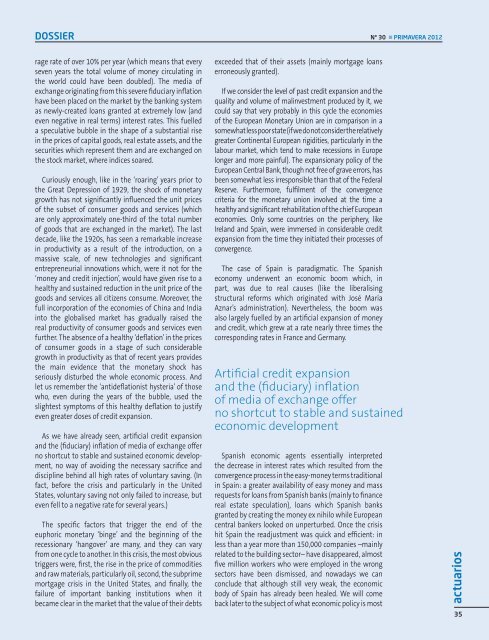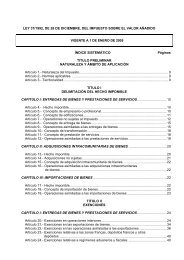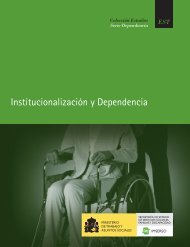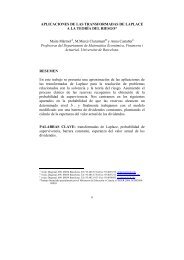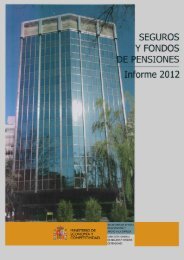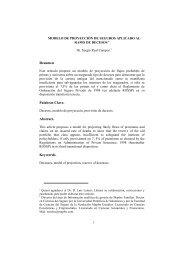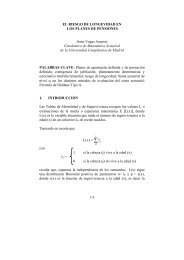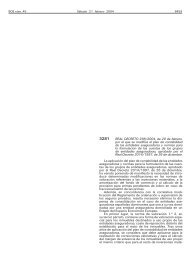REVISTA COMPLETA (pdf) - Instituto de Actuarios Españoles
REVISTA COMPLETA (pdf) - Instituto de Actuarios Españoles
REVISTA COMPLETA (pdf) - Instituto de Actuarios Españoles
You also want an ePaper? Increase the reach of your titles
YUMPU automatically turns print PDFs into web optimized ePapers that Google loves.
DOSSIERNº 30 ■ PRIMAVERA 2012rage rate of over 10% per year (which means that everyseven years the total volume of money circulating inthe world could have been doubled). The media ofexchange originating from this severe fiduciary inflationhave been placed on the market by the banking systemas newly-created loans granted at extremely low (an<strong>de</strong>ven negative in real terms) interest rates. This fuelleda speculative bubble in the shape of a substantial risein the prices of capital goods, real estate assets, and thesecurities which represent them and are exchanged onthe stock market, where indices soared.Curiously enough, like in the ‘roaring’ years prior tothe Great Depression of 1929, the shock of monetarygrowth has not significantly influenced the unit pricesof the subset of consumer goods and services (whichare only approximately one-third of the total numberof goods that are exchanged in the market). The last<strong>de</strong>ca<strong>de</strong>, like the 1920s, has seen a remarkable increasein productivity as a result of the introduction, on amassive scale, of new technologies and significantentrepreneurial innovations which, were it not for the‘money and credit injection’, would have given rise to ahealthy and sustained reduction in the unit price of thegoods and services all citizens consume. Moreover, thefull incorporation of the economies of China and Indiainto the globalised market has gradually raised thereal productivity of consumer goods and services evenfurther. The absence of a healthy ‘<strong>de</strong>flation’ in the pricesof consumer goods in a stage of such consi<strong>de</strong>rablegrowth in productivity as that of recent years provi<strong>de</strong>sthe main evi<strong>de</strong>nce that the monetary shock hasseriously disturbed the whole economic process. Andlet us remember the ‘anti<strong>de</strong>flationist hysteria’ of thosewho, even during the years of the bubble, used theslightest symptoms of this healthy <strong>de</strong>flation to justifyeven greater doses of credit expansion.As we have already seen, artificial credit expansionand the (fiduciary) inflation of media of exchange offerno shortcut to stable and sustained economic <strong>de</strong>velopment,no way of avoiding the necessary sacrifice anddiscipline behind all high rates of voluntary saving. (Infact, before the crisis and particularly in the UnitedStates, voluntary saving not only failed to increase, buteven fell to a negative rate for several years.)The specific factors that trigger the end of theeuphoric monetary ‘binge’ and the beginning of therecessionary ‘hangover’ are many, and they can varyfrom one cycle to another. In this crisis, the most obvioustriggers were, first, the rise in the price of commoditiesand raw materials, particularly oil, second, the subprimemortgage crisis in the United States, and finally, thefailure of important banking institutions when itbecame clear in the market that the value of their <strong>de</strong>btsexcee<strong>de</strong>d that of their assets (mainly mortgage loanserroneously granted).If we consi<strong>de</strong>r the level of past credit expansion and thequality and volume of malinvestment produced by it, wecould say that very probably in this cycle the economiesof the European Monetary Union are in comparison in asomewhat less poor state (if we do not consi<strong>de</strong>r the relativelygreater Continental European rigidities, particularly in thelabour market, which tend to make recessions in Europelonger and more painful). The expansionary policy of theEuropean Central Bank, though not free of grave errors, hasbeen somewhat less irresponsible than that of the Fe<strong>de</strong>ralReserve. Furthermore, fulfilment of the convergencecriteria for the monetary union involved at the time ahealthy and significant rehabilitation of the chief Europeaneconomies. Only some countries on the periphery, likeIreland and Spain, were immersed in consi<strong>de</strong>rable creditexpansion from the time they initiated their processes ofconvergence.The case of Spain is paradigmatic. The Spanisheconomy un<strong>de</strong>rwent an economic boom which, inpart, was due to real causes (like the liberalisingstructural reforms which originated with José MaríaAznar’s administration). Nevertheless, the boom wasalso largely fuelled by an artificial expansion of moneyand credit, which grew at a rate nearly three times thecorresponding rates in France and Germany.Artificial credit expansionand the (fiduciary) inflationof media of exchange offerno shortcut to stable and sustaine<strong>de</strong>conomic <strong>de</strong>velopmentSpanish economic agents essentially interpretedthe <strong>de</strong>crease in interest rates which resulted from theconvergence process in the easy-money terms traditionalin Spain: a greater availability of easy money and massrequests for loans from Spanish banks (mainly to financereal estate speculation), loans which Spanish banksgranted by creating the money ex nihilo while Europeancentral bankers looked on unperturbed. Once the crisishit Spain the readjustment was quick and efficient: inless than a year more than 150,000 companies –mainlyrelated to the building sector– have disappeared, almostfive million workers who were employed in the wrongsectors have been dismissed, and nowadays we canconclu<strong>de</strong> that although still very weak, the economicbody of Spain has already been healed. We will comeback later to the subject of what economic policy is mostactuarios35


